
The bitLanders Film Series to Support Women Empowerment: TULIP FEVER - Photo edition by Amber255 via Bitlanders.com
Famed with serious films, costume drama The Queen's Sister and Oscar-nominated biography Mandela: Long Walk to Freedom, the director, and producer of some of his own directed films, scriptwriter and actor Justin Chadwick invited us to find the seventeenth-century fairy-tale beauty in Amsterdam that reappeared on cinema screens thanks to the book "Tulip Fever" written by Deborah Moggach in 1999.
The film features even three Oscars winners: Judi Dench, Christoph Waltz, and Alicia Vikander; the main story is about love and business. True, the path of history itself to the big screens was not very easy and lasted almost two decades.
Deborah Moggach wrote that when handed the book to the publishing house, she received Steven Spielberg's call. He called from his car and said he bought the rights to create a movie. The film received 48 mln. dollar budget and roles should perform by absolutely other actors. John Madden had to be the director of the drama. In Britain, 12,000 tulips were set up for filming. A few days before the start of the works, the laws in Britain have changed, and because of the funding losses, filming had not started.
Then, for many years, it was planned to create a movie in another country, but plans were not implemented. Later, the novel was read by director Justin Chadwick, and he invited three winners of the Oscars to realize the dream of the writer allowing her to see her creation on the cinema screen, just much more matured, refined to little things.
Beauty, passion and tulips are the themes of this rich and enjoyable foray into 17th century Amsterdam where the riches of the purse, the heart and the bedroom are at odds. It's about forbidden love in a gorgeous setting... - Louise Keller, Urban Cinefile
Credit: rottentomatoes.com
The drama TULIP FEVER tells us an amazing, intriguing story about human greed, not measured hopes, and great love; its action takes us to the 17th century's Amsterdam.
Costume drama is a pretty predictable thing. These are rather atmospheric films, with particularly important decorations, clothing. And, in most cases, the love story, the noblemen's passions and the troubles of the poor people are drawn into all this charmed clothing.
Justin Chadwick's TULIP FEVER is trying to replicate all the canons of the genre, but also add new colors. But did all this mix succeeded?
Tulip Fever - Official Trailer - Justin_Chadwick via Bitlanders.com
The Short Story Of The Movie
In the seventeenth century, tulips reigned in the Netherlands. The newly emerging types of exotic flowers cost very much. However, what happened in Amsterdam in 1637 was completely beyond comprehension. A rare tulip bulb could cost as much as an experienced craftsman earned over a decade! The totally uncontrolled tulip market was the path to wealth and success until country's government interfered and crazy speculation with tulips came to an end. Those who did not rush to get rid of their expensive tulip bulbs were left to broken dreams.
Young girl Sofia (Alicia Vikander), patronized by the elder of the monastery (Judi Dench), was forced into the marriage with one of the wealthiest town merchants Cornelis Sandvoort (Christophas Waltzes), who accumulated his wealth by tulip in Amsterdam. For one rare tulip bulb during the peak year of the tulip fever in 1637, merchants could get ten times more than the annual income of a craftsman was.
Cornelis, being a wealthy and extremely good-hearted merchant living in Amsterdam, enjoying his young beautiful wife, orders to portray his young and stunningly beautiful wife Sofia.
In order to fulfill his ambition, he hires a young and promising artist Jan Van Losa. But the merchant could not even imagine that the artist's acquaintance with his wife would turn into a story full of betrayals. Poor but talented painter Jan van Loos (Dane DeHaan), and the young Sofia fell in love.
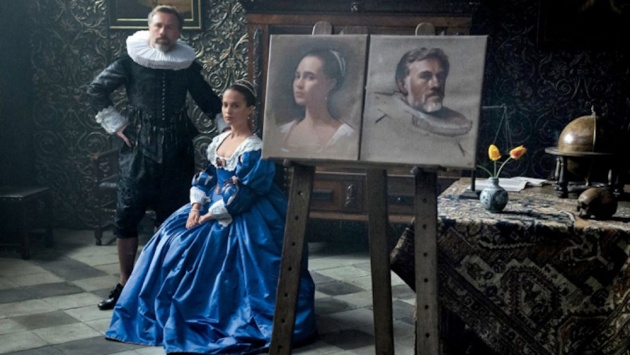
Christoph Waltz and Alicia Vikander in TULIP FEVER - Photo credit: imdb.com
Young people were forced to hide and steal rare moments of tenderness because they were well aware that simply escape will not succeed. An envious rich merchant will not spare time and money to get back his young wife.
Realizing that money can only be fought with money, Jan decides to get himself into a very profitable tulip market. After discussing the plan with his beloved, Jan collects all the money he has and takes a decisive step, supported only by the hope that with the help of Providence, he will get the bulb of tulip, creating wealth and giving up freedom.
The Content Of The Movie
We had to wait for Justin Chadwick's new work a few years because film producers brothers Weinstein decided a few times to intervene in the filming of this movie, and at the same time distorted the original version, which was fully finished by the director in 2015. And that did not promise anything good, especially since the premiere of the film was delayed every few months until finally the film was postponed to September 2017. And this is not the first such deal of brothers Weinstein.
We all remember greatly what happened to the biographical drama Grace of Monaco, which presented the tragic story of the legendary Hollywood actress Grace Kelly. Due to the continuous interference of these two producers in the film process, the film has become extremely weak. Therefore, it was simply impossible to wait for something good from TULIP FEVER.
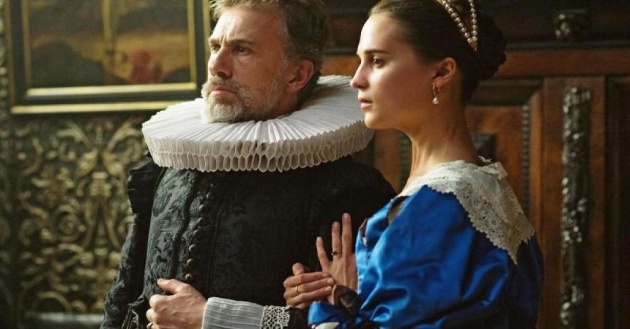
Costume Drama TULIP FEVER - Photo credit: mobile.twitter.com
However, after watching the movie to the fullest, it did not cause any bad emotions, and it was not boring.
About movies like TULIP FEVER says Costume drama. The decorative side of the film is great, and this is a sufficiently important aspect of costume drama.
Tulips are, on the one hand, a background, on the other hand, one of the motive forces of the plot. The tape is full of intrigues, secrets, betrayals, forgery, poverty and wealth, lies, passion, love, scandals.
Of course, after a completely intriguing trailer that shows all the beauty of Amsterdam and its flaws, coming to the cinema hall, the viewer may be disappointed because it is a typical romantic film. The film consists of several love stories, which become the driving force behind this narrative.

History film TULIP FEVER - Photo credit: gowith-theblog.com
The first is the relationship between merchant Sandvoort and his wife Sofia, which is very similar to the usual routine of the family. Another part of the narrative is the love story of maid Maria, living at the house of the merchant, and young fish vendor Willem (Jack O'Connell). All those romances are overshadowed by Sofia and young artist Jan suddenly falling in love. And that is all - that's exactly what we get when watching at this very nicely created yet soulless movie project.
But, in my opinion, the camera does not attempt to subtly portray the feelings of the characters, and the script does not give any attention to the analysis of the inner world, the meaning of their actions. Actors in this film, like the amazingly restored Amsterdam streets, are just a shimmering scenery.
The film is soulless because of the fact that there is nothing positive about it, what at any moment could cause some warm emotions. The movie is dominated by lies, deception, betrayals, and the love itself seems so unbelievable.
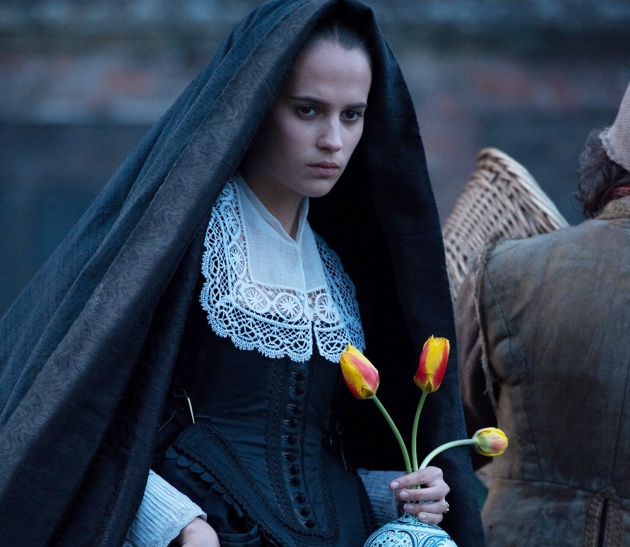
History Film TULIP FEVER - Photo credit: home.fzl99.com
The main heroes Sofia and Jan, who become responsible for all the misfortunes of this story, are not able to involve viewers with their love games. I did not feel the love here; it's just a desperate satisfaction of passion. And it made me most sad because reading the book I could have felt the aura of each hero, identify with their destinies, and perceive the internal pain of the loss.
But the story looked rather interesting, so the time in the cinema run out pretty fast. But this is apparently because we were allowed to enjoy the wonderfully looking Amsterdam and see every single dirty side of it - from alcoholism and the greed of people to the prostitution and amorous pleasures. And this is the strongest element of this film, which does not cause any discomfort at all.
While reading movie TULIP FEVER review, check the QUERLO CHAT: What kind of movies do you like?
The Technical Side Of The Movie
The visual part of the film compensates all of the plot's gaps. It is a beautiful perfect in its own form, which allows you to dive into a truly realistic 17th-century Amsterdam. Both the costumes of the actors, as well as the natural scenery and background images created with the help of CGI are amazing and eye-catching. And I'm not talking about hair and hairstyles, which also contribute to a qualitatively-looking unity.
The camera work also delighted my eyes. The film presents a number of scenes where the details of Amsterdam, its inhabitants and, of course, the action itself are very well presented. It's possible to partly fall in that period because everything has been filmed so inclusively and kindly to the eyes.
Music is not bad either. Well-chosen musical compositions, which from time to time create a more dramatic atmosphere, but I cannot say that it's a very memorable soundtrack that will last a long time in the head when you are out of the film session. Really not. But watching a movie, it does not disturb and gives a pleasant viewing experience.
Sound montage is of high quality, somewhere even very responsibly reinforced. Unfortunately, I cannot say the same about video editing. And here again is Brothers Weinstein's work. They have been featured in the film industry as masters who are able to cut off a number of important and even essential scenes. And it was felt watching this tape. Several scenes were so badly mounted and clipped that it was difficult to watch them.
Behind The Scenes | TULIP FEVER - Video credit: RoadshowFilms via YouTube.com
Scrupulous Amsterdam And Beautiful Costumes
If the developers of the TULIP FEVER made any mistakes, they still deserve the highest ratings for the atmosphere. In costume drama, the actors' outfit and the environment are no less important than actors or scenes. Characters seemed to be coming down from Rembrandt's picture, so the movie costume designer and Oscar winner Michael O'Connor deserve applause.
Not really the actors, stories, music, or even great clothes in the movie play the first violin. The main star of the film is detailed 17th century's Amsterdam. We can admire the thorough restoration of the city's life in every scene where actors go on the streets of the capital of the Netherlands.
The focus was on every detail. Street merchants, celebrities, beggars, wealthy merchants, their steadfast houses, and the port of Amsterdam with the goods that come from the far corners of the world- everything was presented so well.
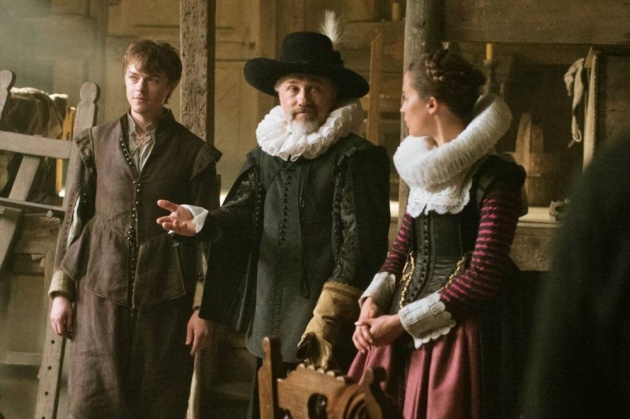
History film TULIP FEVER - Photo credit: forum.purseblog.com
Costume drama TULIP FEVER presented us a very authentic view and made it possible to feel the rhythm of one of the most magnificent cities of that time - Amsterdam.
Costumes are worth attention too. It is very interesting to look at suits embroidered and lace. Men outfits, perhaps, are more interesting than women's, some collars and hats are worth attention.
The Collective Work Of The Actors
As for the actor, I can only say that this is one of the cases when a whole group of virtuoso performances is gathering in the film, but their potential is not fully used of.
Christoph Waltz, the two Oscars' winner, was just bleak in the background of the whole film, but in any case, his performance was the brightest among all the other actors. Of course, charisma determines a lot, because that person radiates it in every project.
Alicia Vikander, Oscar winner for the best second-rate female role in The Danish Girl, also did not stand out with something unusual. The only interesting moment was that you could see her naked again. The owner of the spectacular body, it's only a pity that without the perfect body, the actress in this film could not demonstrate anything memorable.
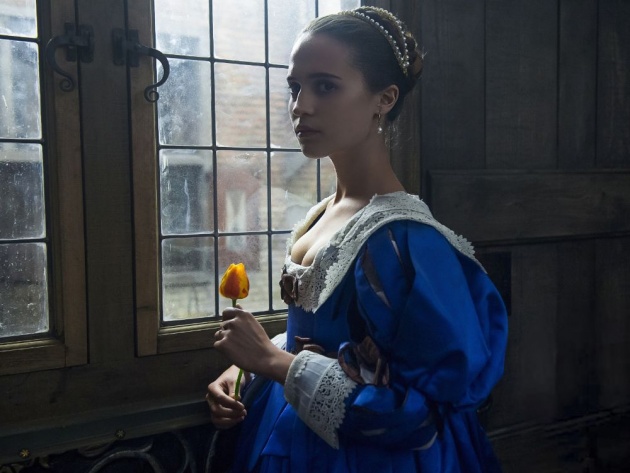
Alicia Vikander in TULIP FEVER - Photo credit: imdb.com
Dane DeHaan, who is sometimes able to amaze with his performance, in this film, was similar to a sex maniac and a zombie thirsty for money. At one point it seemed like he is not feeling comfortable there. Similarly looked another talented young man, Jack O'Connell: no expressions, no devotion to the role.
In addition, the film featured other well-known faces such as Zach Galifianakis, Cara Delevingne, Kevin McKidd, and Holliday Grainger. But they were simply pushed to the second plan. Episodic roles that did not lead to anything. The only one from the second-rate actors who at least somewhat enliven the situation was Tom Hollander. It's a pity that we rarely see him on screens - very fun actor.
The Main Protagonist Role And The Lessons It Gives To Us
A similar plot, especially if it concerns the adultery in the days of the old world, already in itself contains tragedy. The strength of church norms is still strong, family and marriage are not built on the basis of love, but on the basis of rigid traditions that hide inequality and suffering.
After marriage, Sofia is guaranteed a safe and well-off life, but she does not feel happy.
She entered the orphanage barefoot, and left it in the carriage.
Credit: words from the movie
A young wife, in spite of an unequal marriage, lives more than well in the house of a loving husband. She is valued, pampered, and respected, despite some, seemingly important moments in their situation. She is all right until Love comes: a charming poor artist who came to the house to paint a portrait of the owners.
The passion between the protagonists - Sofia and the young, poor artist flares up after the first meeting.
An enterprising orphan Sofia, after thinking, devises how to solve all the problems together: at the same time to deceive the husband, give him what he wants, help the poor Maria to avoid the life of a single mother, and to run away with her beloved. Meanwhile, the plan of the unfaithful spouse is slowly being implemented into life; her lover tries happiness on the tulip market with the aim of providing a lucrative future. (I do not want to spoil the preview so will not go into details).

Sofia and husband - scene from TULIP FEVER - Photo credit: toomar.net
The Sofia looks like a bird first closed into a golden cage. The actress plays the tension of the young girl with small nervous movements, occasionally bursting through the mask of a noble spouse. With the appearance of Jan van Loos, these movements turn into a trembling, and then - into a storm. The bird breaks out to the freedom, it is unbearable for her to be just an object of admiration, she needs a flight.
Thus, the cunning plan of escaping to another life is born; it seems perfect to Sofia, and it reveals its horrible essence only after implementation. Games with death and honor do not lead to anything good. Enchanted Jan helps her, but his attempts to earn on a rare tulip coincide with the fall of the market. The bids were high; losses were irreversible. An invaluable bulb, an object of lust and trading, has become a simple flower.
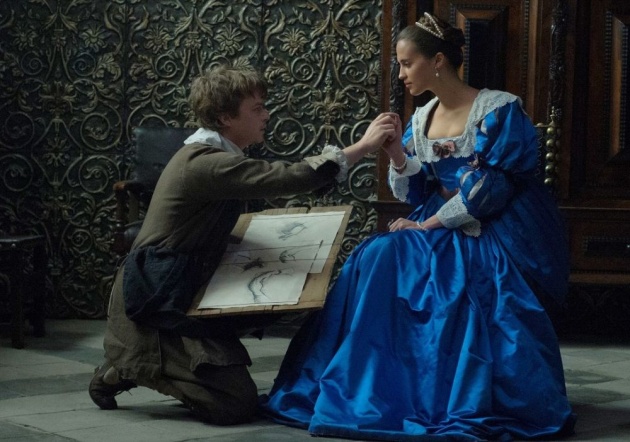
Sofia and Jan - scene from TULIP FEVER - Photo credit: news.google.com
Their wonderful feeling will be ruined by the trade of tulips bulbs. The film is not even about love, but about how the pursuit of wealth destroys the emerging feelings. This is a film about how terrible and destructive any passion can be; about how hard the consequences of such a fever not only for the sick ones but also for anyone who will be close by. And this is a film about the ability to understand and forgive, to release your own and other's sins from yourself, don't allow the madness overwhelm yourself and don't multiply it with your own malice. Atonement can have different forms, but repentance without mercy is worth nothing.
After watching involuntarily once again, you catch yourself thinking that love and passion are not the same things, that physical intimacy is just a part of love, but not its foundation. Just like the momentary thirst for profit, which forces us to betray our vocation, is a path that rarely leads to good.
While reading movie TULIP FEVER review, check the QUERLO CHAT: Do you support women empowerment?
On The Final Note
TULIP FEVER is not a boring movie at all, based on the book of Deborah Moggach with the same title. The impressively looking Amsterdam of the 17th century, which perfectly depicts the flaws and the most hided desires of the people. saves a film from the complete failure of scriptwriters and producers. It also brings a memorable visual impression, with an authentic presentation of the period.
The film has a lot of beautiful, historical images that it's a pleasure to look at, but it has little to do with real people of the seventeenth century and their lives because creators are trying to convey the lives of these people only with empty costumes and expensive decorations.
Summary, TULIP FEVER is a film that involves a great failure and no less success. In the sense of storyline, the film falls and can not get up. But the atmosphere of Amsterdam built to the smallest details, beautiful costumes make this movie worth watching.

Alicia Vikander, TULIP FEVER - Photo credit: laineygossip.com
I liked the film. I watched it with interest because I like films of this kind - history films. Here you can catch the spirit of that era, try to find out how people lived at that time and what moral values they had. The Middle Ages, this is an unusual combination of piety and debauchery, and therefore this topic is interesting.
Times change, but whether it's the 17th century or the 21st century - we are all the same people with the same problems and desires that the heroes of our film face.
Stories don't end. They only go their separate ways. We take leave of them. Not knowing what comes after. - Maria (TULIP FEVER)
Credit: imdb.com
My rating: 7.0/10
Rotten Tomatoes: 44/100
Critics average: 44/100
IMDb: 6.2/10
HAVE FUN WATCHING!
**************************************************************************************************
Thank you for stopping by and reading my blog.
2018, All Rights Reserved.
You are very welcome to join Bitlanders and share your valuable knowledge and opinion.
**************************************************************************************************



